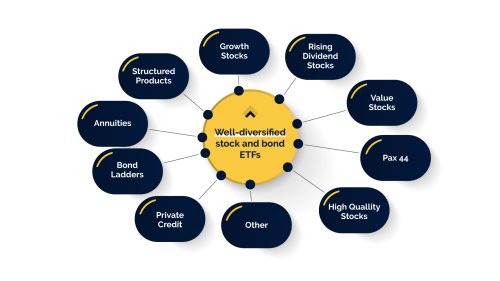Core-satellite Investing in San Antonio

Core-satellite investing in San Antonio is like building a well-designed, custom home. It starts with a solid foundation built to last, and then you add custom features to make a building your home for years to come. Like every home has a unique design, so should your financial strategy – built around your circumstances, timelines, and goals.
In general, one-size-fits-all, cookie-cutter solutions do not work for most people. It’s a simple fact that all investors are not the same. Their differences are reflected in the strategies they select for their financial futures.
At PAX Financial Group, we understand that no two investors are the same. Whether in your peak earning years or preparing to retire, our San Antonio financial advisors team specializes in developing Core-satellite investment strategies that last a lifetime.
This Quick Guide will explain core-satellite investing and provide examples that describe how it can be utilized to protect, nurture, and add to your wealth during working and retirement years.
What is Core-Satellite Investing?
 Core-satellite investing is a sophisticated financial strategy that enhances investment returns by combining broad-market, low-cost investments at the core of a portfolio with smaller, higher-risk, more targeted investments called satellites.
Core-satellite investing is a sophisticated financial strategy that enhances investment returns by combining broad-market, low-cost investments at the core of a portfolio with smaller, higher-risk, more targeted investments called satellites.
The portfolio's core typically includes diversified, passive investments such as index funds or ETFs that track major market indices. This portion is designed to provide stable, long-term growth. On the other hand, satellite investments are actively managed and may include sector-specific funds, individual stocks, or alternative types of investment.
Think of it as a portfolio of blue-chip, large capitalization investments (large cap) surrounded by smaller capitalization investments (small cap) that have the potential to produce higher returns.
Historically, core-satellite investing emerged as a more balanced approach to portfolio management, allowing you to take advantage of bigger and smaller capitalization stocks in the same portfolio.
As the investment world evolved over the past few years, so did the number of available financial products, making it necessary to find a middle ground between higher-risk and lower-risk investment strategies. By focusing most of your portfolio on low-cost, more conservative core holdings, you can keep costs and risks under better control while using satellite positions to seek higher returns or tailor your exposure to specific sectors.
This makes it particularly appealing if you want increased diversification without forgoing the possibility of enhanced returns.
Consider using an S&P 500 ETF (Exchange Traded Fund) as the core of your portfolio, supplemented by satellite investments in technology stocks, energy, or emerging markets. This strategy provides broad exposure to the overall market while allowing more targeted investments in stocks with greater growth potential.
Are you concerned about your investments in an election year? Watch our podcast, “Investing in a Year of Political Noise.”
Who Should Consider Core-Satellite Investing?
As noted earlier, core-satellite investing is not a one-size-fits-all strategy. Suppose you are a high-net-worth couple living in San Antonio. This type of investment strategy may benefit you if you want to maintain a solid foundation of high-quality investments while pursuing more targeted opportunities capable of producing higher risk-adjusted rates of return.
If you have significant wealth and are concerned about the relationship between risk and return, consider a core-satellite investment strategy.
If you have a $5 million portfolio of securities, you might allocate $3.5 million to core investments using a diversified portfolio of index funds. Your goal: Match the markets’ rates of return. Then, you have $1.5 million for satellite investments in Texas-based real estate development projects or energy infrastructure funds.
Over time, the core provides steady growth, while the satellites have the potential to add extra gains through strategic, local, and global investment opportunities. This is where the services of a San Antonio CFP ® can benefit your pursuit of financial independence.
When is the Right Time to Implement Core-Satellite Investing?
 The timing for implementing Core-Satellite investing depends largely on market conditions, risk tolerance, and your financial goals. This strategy is often most effective during economic and securities market volatility periods when core investments can provide steadier returns and satellite investments can capitalize on buying opportunities.
The timing for implementing Core-Satellite investing depends largely on market conditions, risk tolerance, and your financial goals. This strategy is often most effective during economic and securities market volatility periods when core investments can provide steadier returns and satellite investments can capitalize on buying opportunities.
However, it can also work well during market downturns because the core is 70% of the portfolio, and the best buying opportunities are during down markets. The satellites represent an even bigger market opportunity when a rebound occurs.
Economic indicators such as GDP growth, interest rate trends, and market volatility should factor into your timing for satellite investment decisions.
When the economy and markets are positive, more aggressive satellite investments should outperform a portfolio’s core holdings that produce market rates of return. Conversely, satellite investments may lose more during market corrections and down markets.
If you’re a young professional in San Antonio, you might consider implementing a core-satellite strategy after reaching a major milestone like a promotion or an inheritance. This could include starting with core investments in broad-market ETFs and gradually adding satellite investments in companies tied to local economic drivers.
Suppose you’re a retiree in San Antonio. In that case, you might shift your satellite investments towards municipal bonds or dividend-paying blue chip stocks, which provide steady income while maintaining the core portion in low-cost index funds that protect the bulk of your wealth.
Long-Term Financial Planning with Core-Satellite Investing
 As the old saying goes, “Failing to plan is planning to fail.” While having a core-satellite investment strategy can be a good move, you may still make poorly thought-out investment decisions without a long-term financial plan that keeps you focused.
As the old saying goes, “Failing to plan is planning to fail.” While having a core-satellite investment strategy can be a good move, you may still make poorly thought-out investment decisions without a long-term financial plan that keeps you focused.
The strategy is designed to provide steady growth by retaining a stable core of diversified, low-cost investments. Satellite investments, although they carry additional risk, provide increased flexibility and the potential to enhance returns by supporting long-term financial goals such as retirement, estate, or legacy planning.
Your long-term financial plan may include creating a separate trust fund for your grandchildren. Your core-satellite investment strategy is key to growing that account over longer periods.
Managing Investment Risk
It’s important to remember to work with a financial advisor in San Antonio who can offset market performance with an acceptable exposure to risk tolerances so you can maintain the right balance in your portfolio.
It may be prudent to consider rebalancing your portfolio annually to ensure that your core investments still represent most of your holdings, which can help keep your risk level in check.
Year-End Tax Planning and Core-Satellite Investing
Tax planning plays an important role in a core-satellite strategy. Core and satellite investments require careful tax management, particularly those that generate significant capital gains. A financial advisor can help optimize your tax situation by identifying opportunities for tax-loss harvesting - selling losers to offset winners' gains.
If you realize $50,000 in gains from selling a profitable satellite investment in the tech sector and have $30,000 in losses from a satellite investment in the energy sector, the net taxable gain is reduced to $20,000. This strategic use of losing investments that manage your tax liabilities enables you to generate some positive benefits even from investments that produce negative rates of return.
Are you looking for more financial balance? Watch our podcast, “Financial Balance in Wealth Management.”
Why Choose Core-Satellite Investing?
Core-satellite investing offers several key advantages.
- It can provide diversification by spreading investments across a wide range of assets. This diversification helps manage risk because the core portion of the portfolio remains more stable, while a smaller portion is more volatile.
- It offers the potential for higher returns by allowing investors to target specific sectors or asset classes that might outperform the broad market.
- Core-satellite investing is highly customizable, allowing investors to tailor their portfolios to their risk tolerance, goals, and market outlooks.
On the other hand, there are some unique challenges to consider:
- Managing core and satellite investments requires more time and expertise than a fully passive strategy.
- The active management of satellite investments can increase costs and risks. Conducting regular reviews and adjusting satellite positions is essential to ensure they stay aligned with overall financial goals.
Managing a sophisticated core-satellite investment strategy may be more challenging than anticipated. To reduce your risk, consider working with an experienced San Antonio investment advisor who can guide you on selecting the right core and satellite investments, rebalancing the portfolio, and controlling costs and taxes.
How to Implement Core-Satellite Investing?
A San Antonio financial advisor can help tailor a core-satellite strategy to your needs. A professional can assist in selecting appropriate core investments, identifying satellite opportunities, and rebalancing the portfolio as needed.
San Antonio CFPs ® can also provide valuable insights into market conditions and help manage overall risk through diversification and strategic asset allocation.
- Identify your financial goals, whether focused on long-term growth, income generation, or wealth preservation. Risk tolerance will also be key in determining the right balance between your core and satellite investments.
- Your portfolio's core should consist of low-cost, broad-market investments such as index funds or ETFs that provide exposure to major market indices like the S&P 500.
- Satellite investments should be more actively managed, including sector-specific funds, individual stocks, or alternative assets such as real estate or commodities. These investments should align with your goals and risk tolerance.
Why Consider PAX Financial Group as Your Financial Partner?
Partnering with PAX Financial Group can make all the difference when implementing a core-satellite investment strategy. Our deep understanding of the markets and personalized approach to planning ensure that your portfolio stays aligned with pursuing your unique financial goals.
Whether you’re seeking growth, preservation, or both, our experienced professionals can help you navigate your options and create a strategy to achieve and maintain financial independence.
Let PAX Financial Group guide you in building a well-balanced and resilient investment plan. Our only goal is to help you pursue your financial goals.

